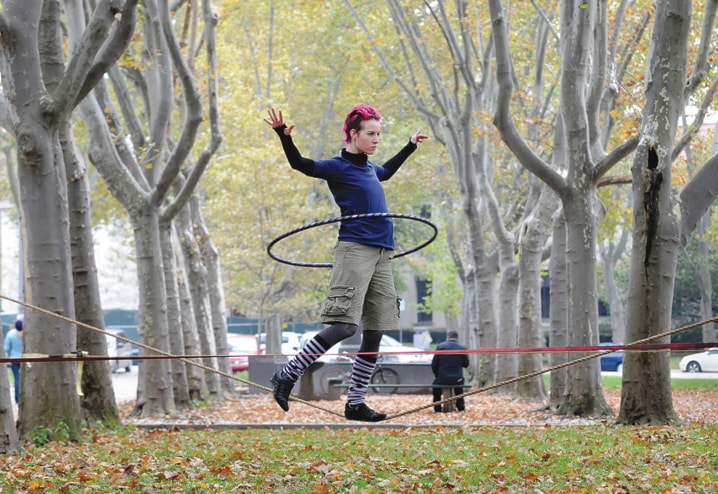On any given Sunday, Slackline Pittsburgh members can be seen suspended in the air between sycamore trees. They walk the line, toeing their way across loosely strung one-inch nylon webbing — a “slackline” about a foot or two off the ground that stretches and bounces with every step.
But they do not just walk from tree to tree. Some practice yoga, bringing one foot to the opposite inner thigh for the “tree” pose, while others juggle or manage to swing their hips inside a hula hoop with one foot on the slackline.
While core members of the group have developed tricks, new members driven by curiosity usually struggle at first just to stand.
“Most people are used to static balance, like balancing on the edge of the sidewalk,” said Laura Lantz, who founded Slackline Pittsburgh in 2009. “The dynamic balance instincts are not quite there yet.”
The distinction separates slacklining from seemingly similar ventures, such as tightrope walking, in which the rope is stretched tightly and remains static. A slackline moves, and when a beginner follows the impulse to concentrate on keeping her feet still, it moves even more, swinging from side to side.
A stable centre of gravity helps with balance on the slackline.
Michael Loomis walked by the group several times before he “got over his fear,” he said, and tried it. Now, he is hooked, trying to master yoga poses off the ground.
“It’s not something you can just get up and do. I had about eight hours of practice before I was comfortable and could walk,” said Loomis.
Though beginners may be daunted at first, Lantz said they should not despair.
The trick? Get on the line and stay there.
“First, get two feet on it, then stand on one foot,” Lantz said. “Try doing crazy things with your arms. Find your more comfortable leg, and when you start walking, step on your other foot just to get back to your ‘safe zone.’ ”
Some people hold hoops in both hands, pressing them to the ground for stability when necessary. Others may tie a line overhead to hold onto. Though it is best to get used to balancing independently, Lantz recommends using “whatever helps you spend time on the line.”
While slackline gatherings are most festive in the summer — with live music on the grass transforming the event into somewhat of a “block party” — Pittsburgh slackliners do not just balance in fair weather. Slacklines can be set up in indoor spaces or outdoors in the cold.
“We’ve been out in the depths of winter, catching snowballs from the slack,” Lantz said. “We tried it at first with shoes, but I like it better barefoot. The snow was incentive to stay on the line.”
There are other ways to make slacklining a bit more extreme.
• Tricklining is a style of slacklining focused on innovating and mastering various tricks, from jumping between lines to back flips. Lantz said the group worked on somersaults over the summer.
• Midlining requires experts to raise the bar, literally, with slacklines hoisted from 20 to 60 feet above ground.
• Highlining involves anchoring slacklines even higher — at more than 1,000 meters or 3,300 feet.
• A national group, Yoga Slackers, visited Pittsburgh this summer to lead a workshop on practicing yoga on a slackline. Other variations include slacklining over bodies of water and using a line with additional slack for Freestyle Slacklining.
For beginners, simply standing a foot or two off the ground is challenge enough. Slackline “kits” are available for US$52 and up — in sporting goods stores or online — and include all components necessary. Those interested can also try it out by borrowing a line from a friend, or finding a group.
Walking the line offers more than the promise of an impressive collection of YouTube productions. It’s low-impact strengthening for the legs and core. It brings physical and mental benefits.
“There’s no room to focus on anxiety,” Lantz said. “You let go of what’s worrying you and focus on the simplest thing: not falling.”
